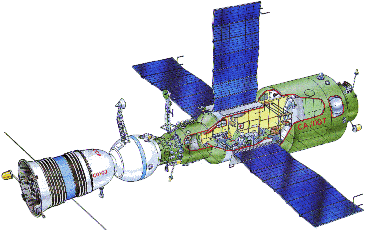
The Salyut-4 space station was launched on 26 December 1974. It was in an
orbit with an apogee of 355 km and a perigee of 343 km. The orbital period
was 91.3 minutes. It was at an inclination of 51.6 degrees. The X-ray
telescope was switched on on 15 January 1975. Salyut-4 reentered the Earth's
atmosphere on 2 February 1977.
The Salyut-4 X-ray instrument, often called the Filin telescope, consisted of
four gas flow proportional counters, three of which have a total detection
surface of 450 sq cm in the energy range 2-10 keV, and one of which has an
effective surface of 37 sq cm for the range 0.2-2 keV. The field of view
was limited by a slit collimator to 3 deg x 10 deg FWHM. The instrumentation
also included optical sensors which were mounted on the outside of the station
together with the X-ray detectors, and power supply and measurement units
which were inside the station. Ground based calibration of the detectors is
considered along with in-flight operation in three modes: inertial
orientation, orbital orientation, and survey. Data could be collected in 4
energy channels: 2-3.1 keV, 3.1-5.9 keV, 5.9-9.6 keV, and 2-9.6 keV in the
larger detectors. The smaller detector had discriminator levels set at 0.2
keV, 0.55 keV, and 0.95 keV.
Among others, observations of Sco X-1, Cir X-1, Cyg X-1, and
A0620-00 were published from the Filin data. A highly variable low energy
(0.6-0.9 keV) flux was detected in Sco X-1. Cir X-1 was not detected at all
during a 5 July 1975 observation, providing an upper limit on the emission
of 3.5e-11 erg/sq-cm/s in the 0.2-2.0 keV range. Cyg X-1 was observed on
several occasions. Highly variable flux, in both the time and energy
domains, was observed.